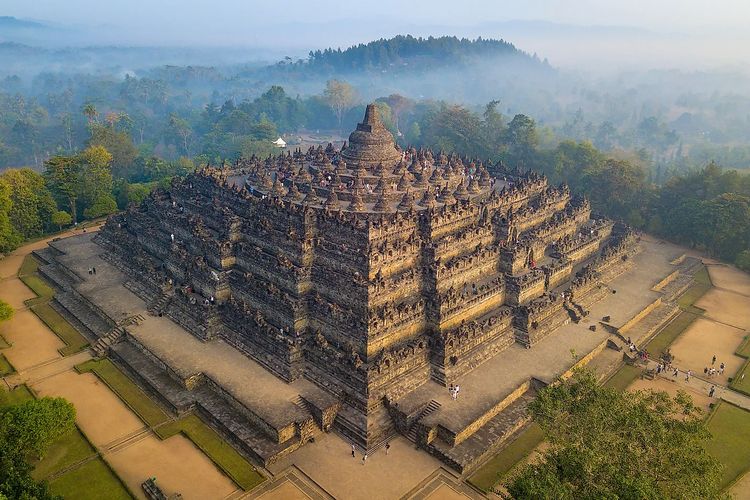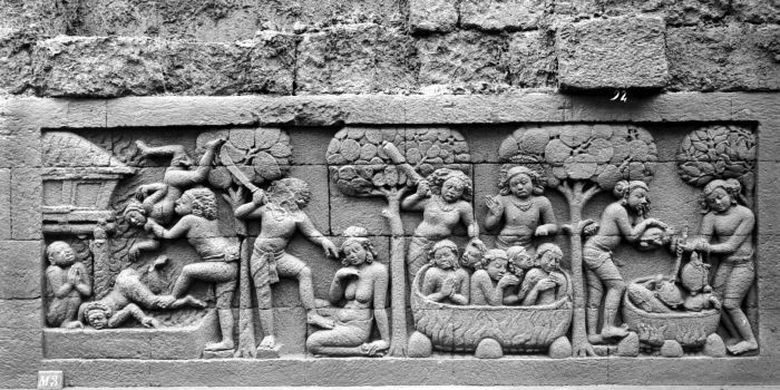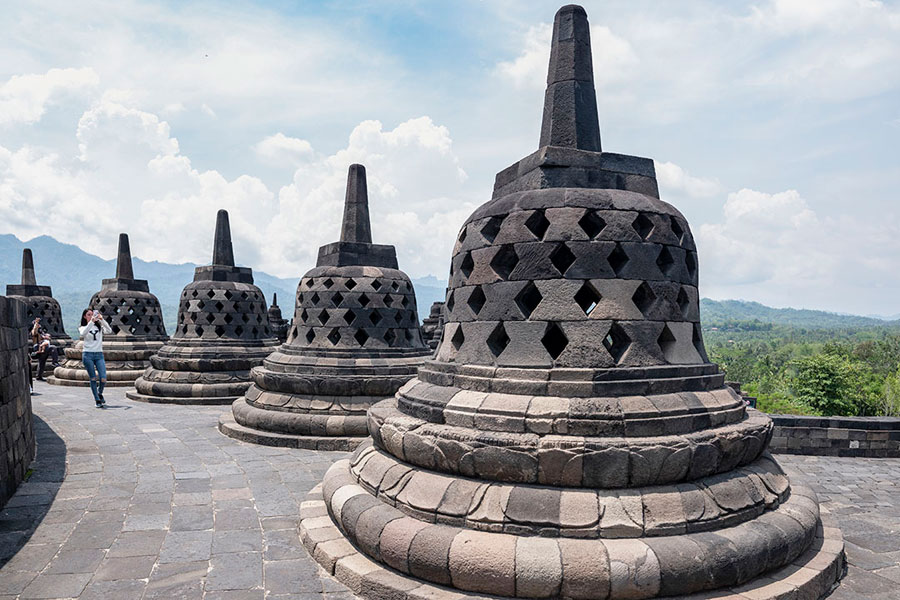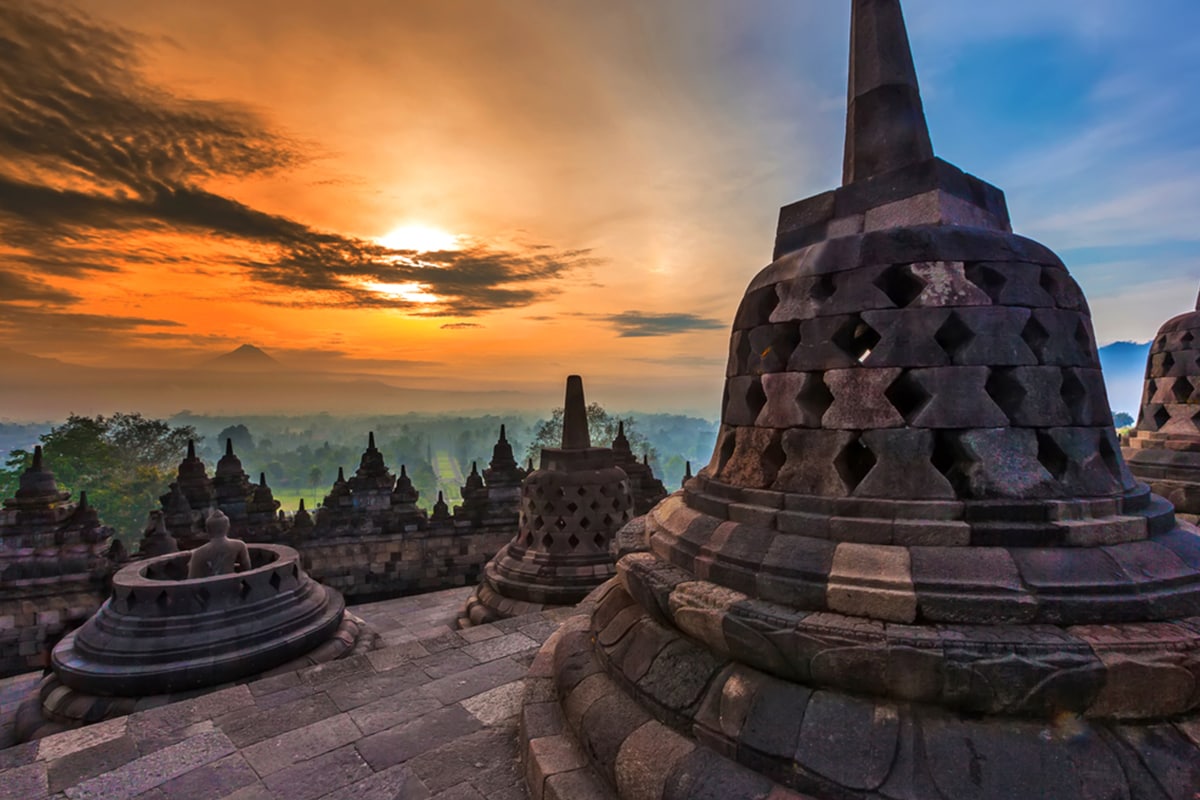
Image Source: Indonesia.travel
Borobudur, with its magnificent architecture and impressive size, never fails to captivate anyone who sees it. As a World Heritage Site, this temple is well-known both in Indonesia and around the world.
Amazing Monument
Borobudur is the largest Buddhist monument in the world. However, there are also many other temples in its vicinity, especially in Central Java and Yogyakarta. The study and preservation of Borobudur have been ongoing since the 19th century. The Borobudur temple has undergone three major restorations: first from 1814 to 1822 by Thomas Stamford Raffles, second from 1907 to 1911 by Theodoor van Erp, and the most recent large-scale restoration from 1973 to 1983 by the Indonesian government and UNESCO.
This monument consists of five square terraces and three circular terraces with 72 stupas, as well as a large central stupa at the top. There are also narrow corridors formed by balustrades surrounding the terraces.
Borobudur features 1,460 narrative reliefs and 1,212 decorative reliefs, totaling 2,672 panels covering an area of 2,500 square meters. When stretched out, the total length of these reliefs reaches 3,000 meters.
Each square terrace faces the four cardinal directions. On the balustrades, there are hundreds of Buddha statues in various poses. The three circular terraces above do not have balustrades and are adorned with stupas, each containing a Buddha statue. The main stupa at the top of the monument has a diameter of 10 meters. The layout of Borobudur covers an area of 123 meters by 123 meters with a height of 35 meters.
Borobudur: As Education and Teaching
The appearance of Borobudur is not only stunning from the outside but also rich with teachings. A local research group, Bumi Borobudur, has identified nearly all of the narrative reliefs. This process helps us understand the values and teachings of Borobudur more completely.
Although the original manuscript that served as the blueprint for Borobudur may have been lost, the reliefs at Borobudur are actually the true “manuscript.” These reliefs, along with the statues and stupas at Borobudur, were designed and created with specific purposes, following a particular sequence and concept.

Image Source: Indonesia.travel
Karmawibhangga
On the ground floor of the temple, there are 160 Karmawibhangga reliefs, almost all of which are now covered by supporting walls. These reliefs teach the principle of ‘ngunduh wohing pakarti’, which means we will reap the results of our own actions. There are 54 sections in Karmawibhangga that explain the relationship between actions and their consequences, emphasizing the importance of living intelligently, virtuously, disciplined, morally, and ethically. These reliefs invite us to live with integrity and politeness, and to interact in society fairly, without violence, and committed to not hurting or harming others.
Jataka and Awadana
On the upper part of the first floor panel, there are 620 reliefs depicting the stories of Jataka and Awadana, and another 100 reliefs on the second floor. These reliefs teach about ‘migunani tumpraping liyan’ - a life that benefits others. This emphasizes the importance of caring and altruistic attitudes, as well as the motivation to continuously improve oneself. The reliefs also display stories about animals, state leaders, and gods, illustrating the importance of cooperation and unity in facing various situations, both in prosperity and challenges. There are also depictions of fair, brave leaders who protect their people.
Sutra Lalitawistara
The Lalitawistara Sutra, carved on the walls of the first floor, consists of 120 reliefs. This sutra tells the story of the ‘Kiprah Pamungkas’, which is the culmination of various rich and complete activities. These reliefs show how various beneficial activities reach their peak with the beginning of the spread of the Teachings.
Sutra Gandawyuha
The Gandawyuha Sutra is the main teaching in Borobudur, carved into 460 reliefs. These reliefs depict the way to achieve perfect knowledge and the highest potential of humans. On the second floor, there are 128 reliefs about the opening and ‘kalyanamitra’ of the Gandawyuha Sutra. These reliefs display a spiritual life full of empathy, confidence, humility, and a desire to learn. These reliefs also teach tolerance towards all genders, ages, professions, wealth, tribes, castes, and religions.

Image Source: BumiBorobudur
Mitra Andalan | Floor 2, Wall
Mitra Andalan section emphasizes the importance of having an open heart, respecting others’ views, and appreciating diversity in a multicultural society. It also shows the importance of perseverance and persistence in cultivating goodness and knowledge. Mitra Andalan consist of various layers of city society, including households, traders, tribal leaders, goldsmiths, linguists, youths, and children.
On the inner wall and the railing wall of the third floor, 176 reliefs are carved, and on the fourth floor, there are 84 reliefs, which depict the main part of the Gandawyuha Sutra. These reliefs aim to ‘memayu hayuning bawana’, or create conditions that allow the highest reality experience of peace. This teaching reveals that the glory and happiness in this world are almost impossible to enjoy alone. True happiness and tranquility can only be achieved with the motivation and determination to involve others, starting from family, society, to the nation and the world.
Bhadracari
The final chapter of the Gandawyuha Sutra is carved on the inner wall of the fourth floor in 72 reliefs known as ‘Bhadracarya-pranidhana’ - the aspiration to live in harmony with ‘all that is good’.
Dharmadhatu and Dharmakaya
At the top of the temple, there are three circular terraces symbolizing Dharmadhatu, a dimensionless space that represents the place where all experiences arise and disappear. There are 72 Jala Stupas and Stapada Stupas representing the experience of absolute reality, each with a unique yet similar form.
The main stupa depicts Dharmakaya, the essence of pure consciousness that forms the basis of all experiences. This signifies the disappearance of boundaries between subject and object, the ability to understand what is immanent and transcendent, freedom from concepts, and the expression of great compassion and true happiness.
Borobudur: As Cultural Heritage

Image Source: Indonesia.travel
Borobudur is an example of the greatness of the friendly, accommodating, sturdy, and resilient Nusantara culture. This temple shows that our culture is open and tolerant. Our nation does not immediately reject or accept ideas from outside, but studies them wisely. This shows that our nation is intelligent and confident.
The art of carving in Borobudur, with its designs and motifs, shows the uniqueness of our nation’s local culture. Although it takes inspiration from Buddhist teachings from abroad, the way it is made shows the skills and expressions of high-quality Nusantara cultural art. This shows that we can adapt religious teachings from outside to enrich our local culture and traditions.
Borobudur is a great work of our nation that deserves to be appreciated. This is an innovation that has never existed before and is unique. The construction of Borobudur not only requires technical expertise, but is also supported by educated human resources and sufficient funds.
Our ancestors showed courage in innovating that created synergy between intelligence, religion, and culture. This produces noble values, norms, and ethics. This life view becomes a guide to build oneself and a cultured society.
Borobudur was built as a teaching and guidance to provide mutual benefits. This temple emphasizes the importance of living based on kindness, openness of heart, justice, and tolerance. This is a guideline for forming a caring family and a harmonious society.
Borobudur also teaches us about a way of life that cares for others. It teaches us to always be beneficial to others, or at least not harm them. This temple reflects the grandeur of Nusantara culture and provides a life guide to achieve the best potential in the family, society, and as a nation.
This guide helps us broaden our horizons, increase tolerance, and sharpen our minds. It forms a personality that has spiritual beliefs, is cultured, and respects each other. Being a human who brings benefits and happiness to the family, society, nation, and country is the goal of this teaching.



